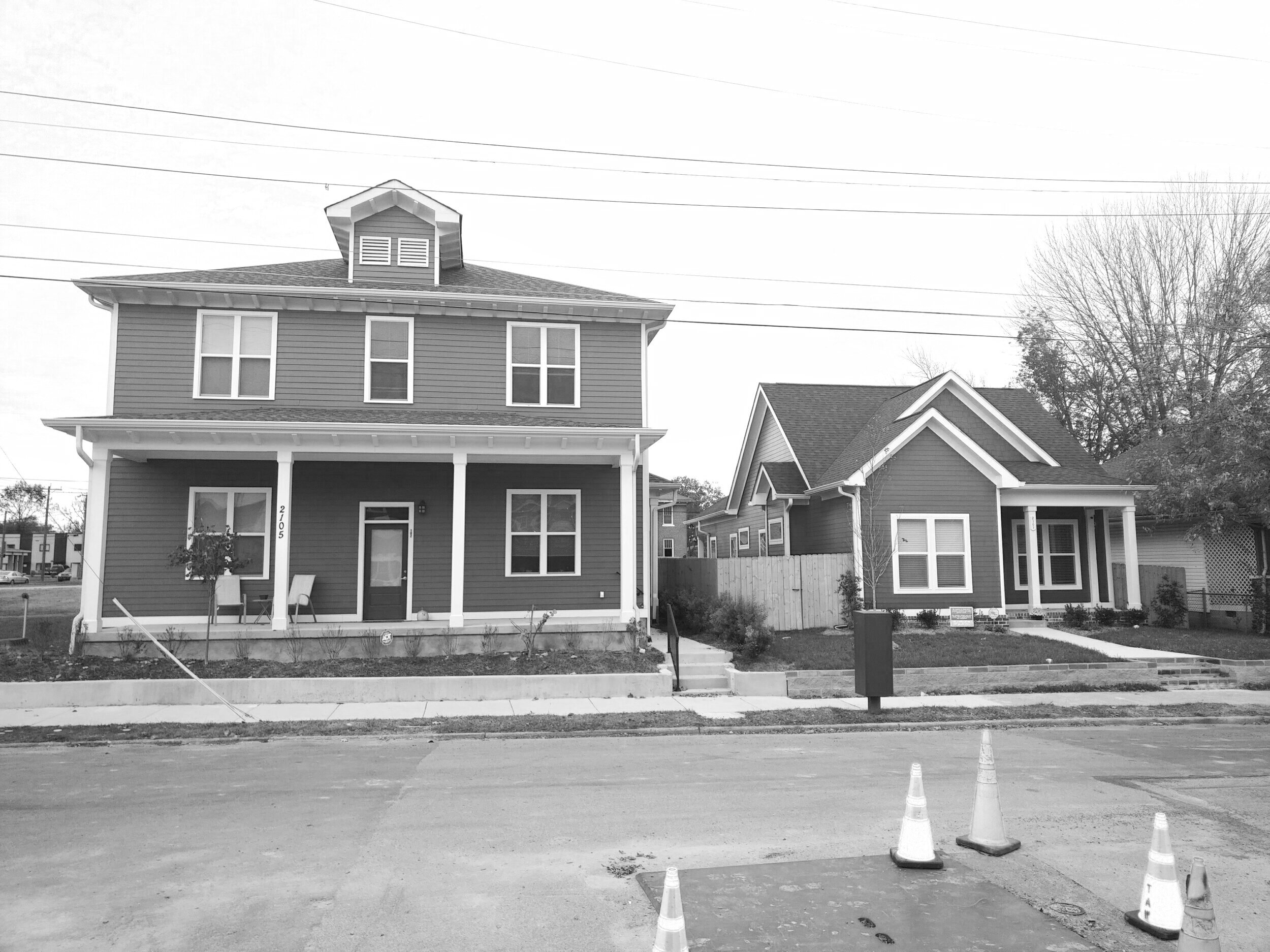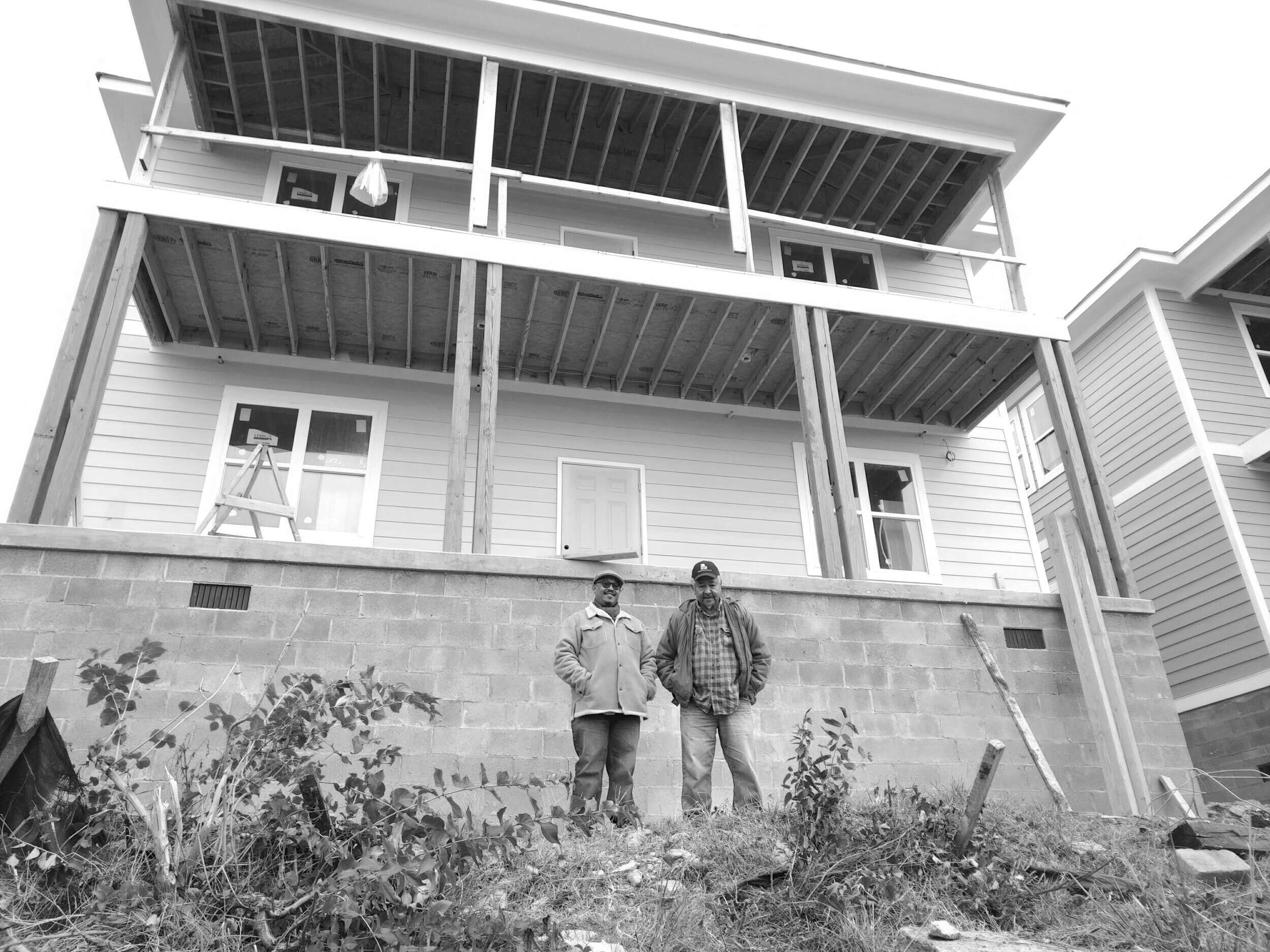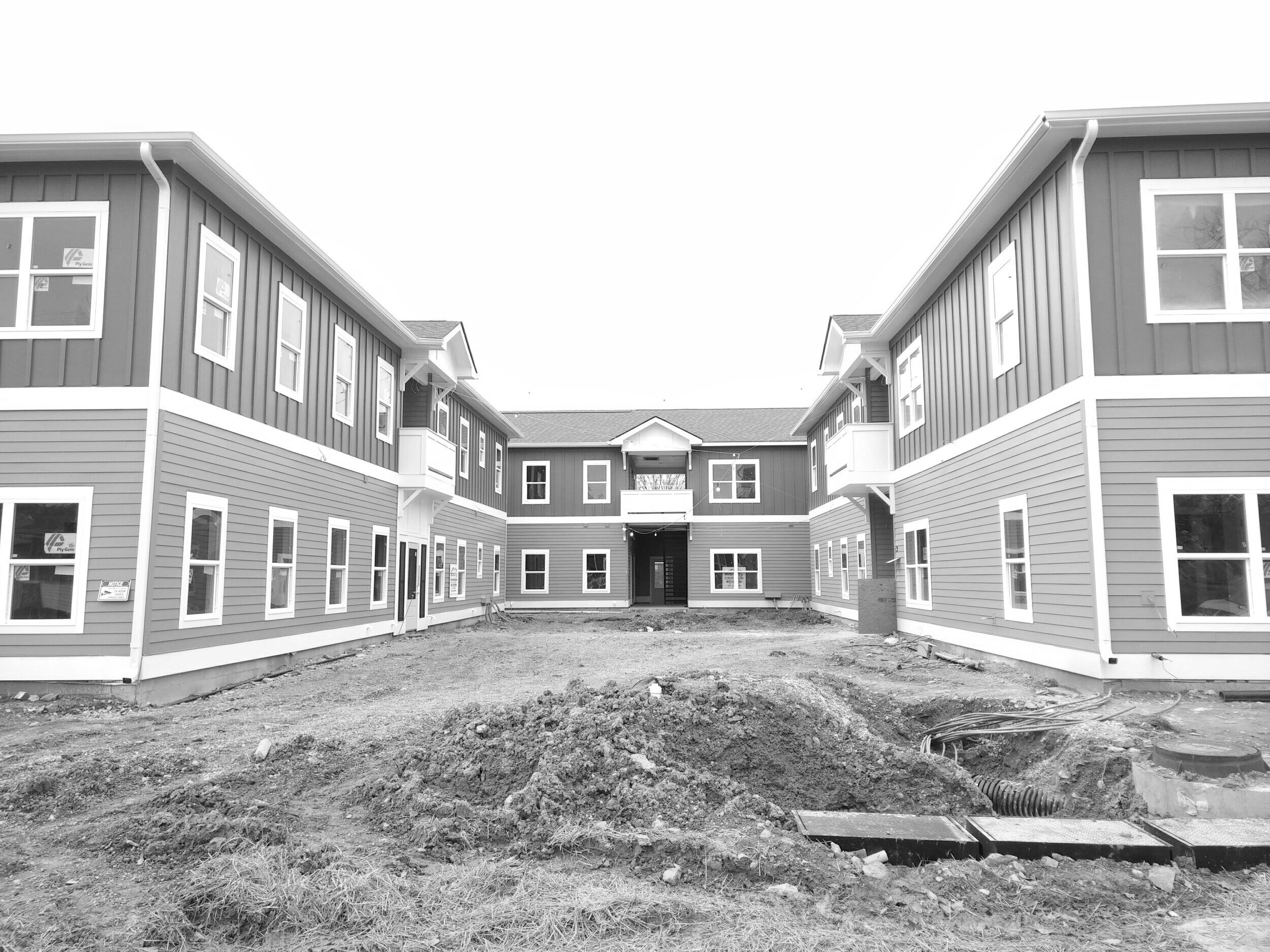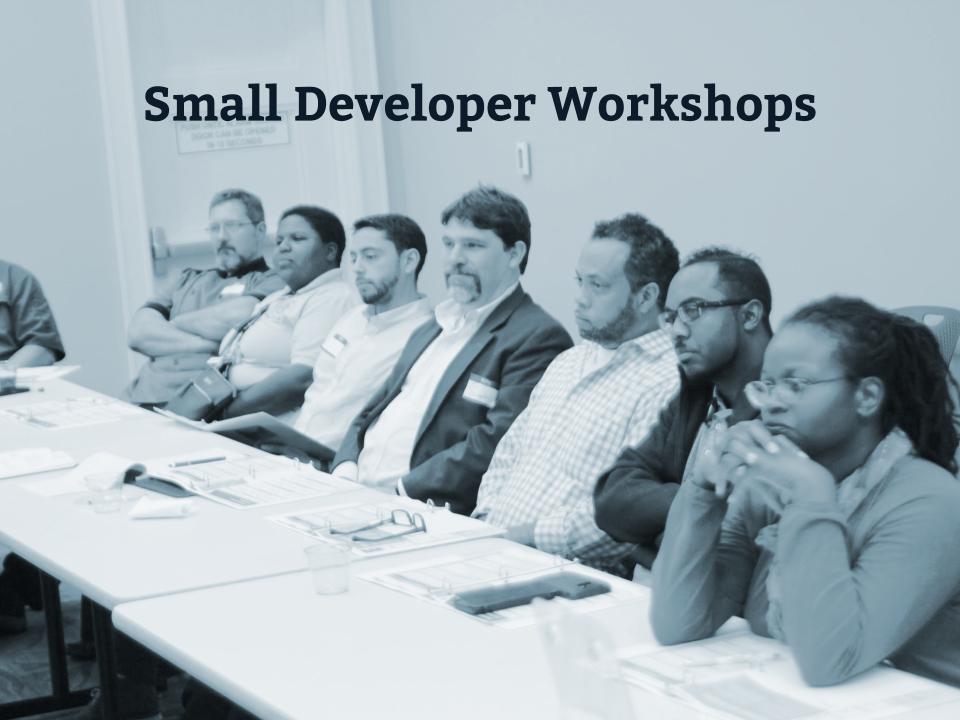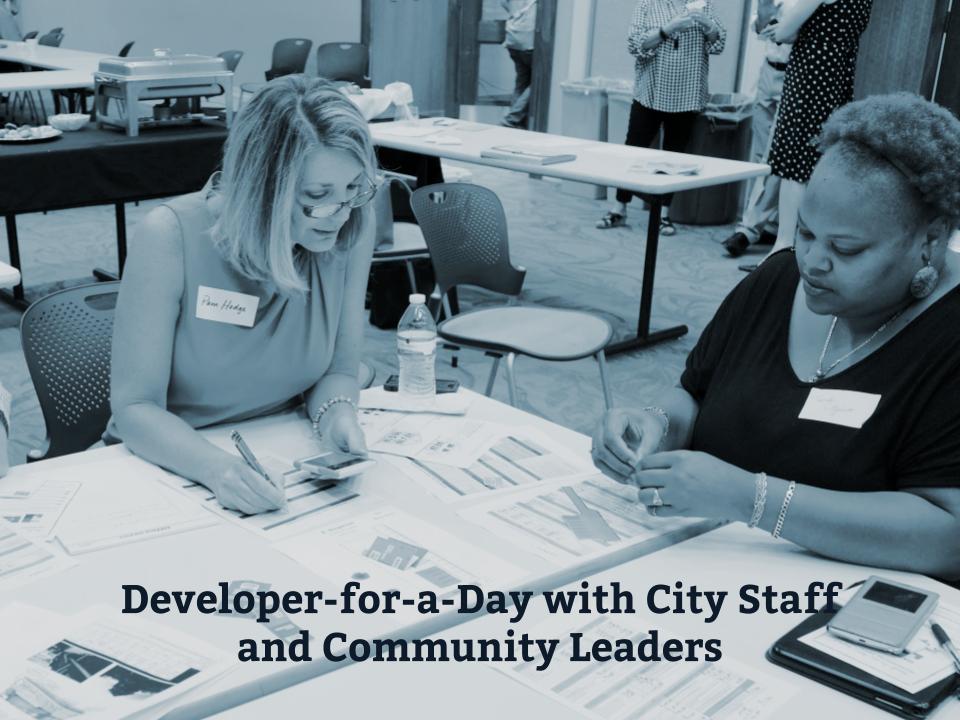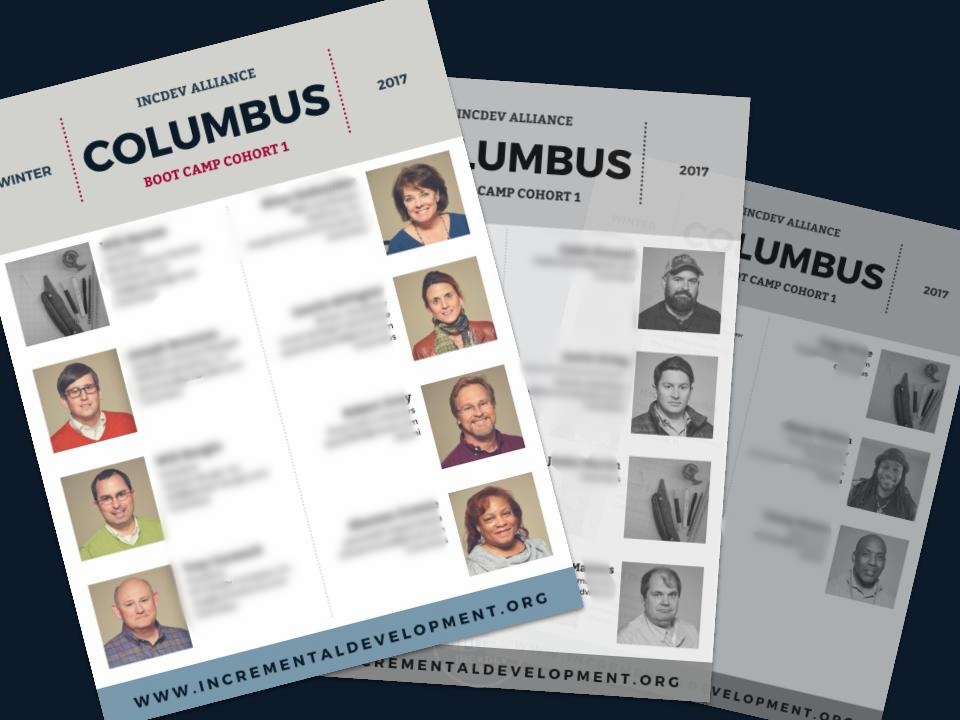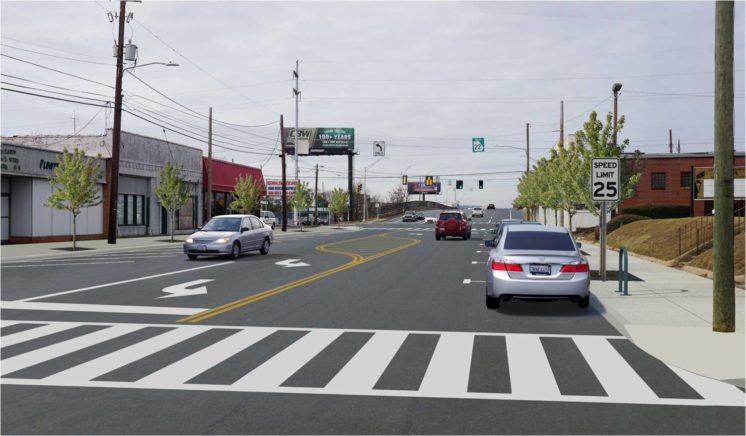
Missing Middle Housing in Chattanooga
Working with the Lyndhurst Foundation and Chattanooga Neighborhood Enterprise (CNE), we are paving the way for great infill development in Chattanooga. The goal is to make it easier to build multi-unit properties that improve their neighborhoods and allow the city to adapt to changing housing needs while honoring the best of Chattanooga’s built heritage.
Beautiful multi-unit properties like 1400 Duncan here are part of Chattanooga's built heritage. Our work is helping to make Missing Middle Housing such as this both legal and straight-forward for local small developers.
Goal: Make the Missing Middle Possible Again
CNE owns several properties in the Highland Park and Ridgedale neighborhoods, upon which they want to make it easier to build the best possible housing. The Lyndhurst Foundation has supported this goal by assembling an IncDev design team to essentially pre-package developments, from finance to floor plan, that would strengthen and beautify neighborhoods, be profitable for a builder, and meet housing demand.
Method: Learn from local, share from experience
Our design team, including Bruce B. Tolar, Architect from Ocean Springs, Mississippi, Kronberg Wall Architects from Atlanta and Brown Design Studio from Savannah, set to work with local implementers to create workable plans, construction estimates and development finance models. The team surveyed Chattanooga to find precedents of much-loved Missing Middle type buildings which would fit nicely in the target neighborhoods. They met with locals in the building trades, visiting job sites and getting continuous feedback, to set a realistic baseline for construction costs, timelines, and processes. The team then held meetings with various administrative departments to clarify purpose and identify red flags in the existing sphere of regulation that may inadvertently preclude development projects.
Outcome: Pre-packaged Missing Middle projects
This project culminated in document which explained the value of Missing Middle housing and provided sample bank packages for folks interested in putting the proposed designs into action. The team then hosted a Small-Scale Development Training Workshop in October 2016, in which locals engaged in the first steps to make the Missing Middle their business. Local developers expressed strong interest in the Missing Middle housing plans proposed in the project document. The IncDev team also diagnosed key thresholds within municipal regulation that could make or break small development projects. The City can refer to the thresholds in this document to guide code evolution. In the meantime, our partners at CNE are building out several of the models from our Missing Middle plans.
Breaking ground with infill Missing Middle in Chattanooga
Code Cracking in Kalamazoo
A dedicated planning official in Kalamazoo suspected something was awry with the city's zoning code when she noticed that the beautiful ideas presented in their Master Plan were not being built on the ground. In particular, she saw the Edison neighborhood as an area with lots going for it, but limited development interest. Her leadership brought us to Kalamazoo to host an Implementation Clinic alongside our Small Developer Training Workshop. We walked the streets of Edison and picked out a number of properties that on the surface looked like great development opportunities. Then, we combed through the zoning code and helped workshop attendees create project proposals for these properties in small groups. In this process, local folks were able to walk through their code and a development pro forma and identify zoning barriers that were explicitly preventing walkable, financially sound small development in Edison.
Two years after our Implementation Clinic in Kalamazoo, city staff are building the political unity to repair a broken zoning code. Our local partners here had done such amazing work over the past few years to develop a great plan for Kalamazoo that a local philanthropist offered a significant sum of money to help implement those city building aspirations. Our partners have undertaken an extraordinary community education and engagement effort to explain where local ambitions are stymied by the current zoning code. They are now rewriting their zoning code to support small scale reinvestment in some of their most neglected urban neighborhoods. This team has spent countless hours in conversation with residents to ensure that as the code is rewritten, locals know how they can employ it to create income-producing buildings and great public spaces.

Ecosystem Coaching in Columbus, GA
A band of organizers, small developers, and city officials see great potential in MidTown Columbus, which sits between a rising downtown and sprawling city edge. We joined MidTown Inc. with the support of the Knight Cities Challenge Grant to create a year-long incremental development intervention.
Our work in Columbus was our first chance as an organization to run the gamut of programming in a single place over an extended period. This deep dive into Columbus helped us create a proper diagnosis on why small development was missing in the target area of Midtown. We came to town aiming to spur a handful of new development projects, but within a few visits it became clear that some more fundamental work was necessary first. Here’s what we did:
Groundwork
First, we did some on-the-ground research, studying local architecture traditions and meeting key people in the neighborhoods we were trying to serve. We sought conversations with business owners, developers, city staff, faith leaders, and neighbors to get a local and nuanced perspective on the status quo. We also hosted an evening of public presentations so that we could share our theory of change with the community.
Joe Minicozzi, principal at Urban3, tells stories of land value using data visualization.
Additional presentations to watch from the evening:
Monte Anderson describes his farming approach to small-scale development in Dallas, TX.
Gracen Johnson tells stories of "homebudding," the virtuous circle arising from the makeshift, often cheeky contributions of neighbors.
Glenn Kellogg shares the story of launching his independent grocery store in downtown Rochester, NY.
DEVELOPER RECRUITMENT & TRAINING
By hosting two training workshops and a recruitment lecture we attracted two dozen aspiring developers to a hands-on boot camp. However, while coaching them through their projects, we discovered that little would pencil in Columbus due to underlying financial and regulatory conditions.
PUBLIC SERVICE COACHING
To set our developers up for success, we analyzed these barriers and ran through a development simulation with city staff called Developer-for-a-Day. This demonstrated to regulators where policy was preventing infill and redevelopment in areas desperate for investment. Working with staff, we summarized these findings in a report which details a recommended zoning overlay district to unlock development potential in Midtown. This report will be presented to council by our developer cohort.
SERENDIPITOUS INFRASTRUCTURE CHANGE
We became instrumental partners in achieving a “road diet” for a critical section of Midtown which is making the rehabilitation of vacant commercial buildings viable for the first time in years. See below for more on this story.
STAGE ONE SITE PLAN HACKS
Finally, we applied our most creative minds to crack the code of site planning for Midtown’s small infill lots. Working with business and property owners, we penned first-stage site plans for specific lots transitioning toward a more mainstreet feel. This process led to at least one business owner committing to a neighborhood infill setting rather than a more car-dependent location.
Public servants were courageous to follow the evidence despite the usual backlash to change.
Transforming 13th Street
We happened to be in Columbus when 13th Street, a state highway constituting Midtown’s commercial spine, was scheduled for re-striping. This created a once-in-a-decade opportunity for the five blocks that had become the epicenter of our efforts.
The conditions were ideal: we had built relationships with property owners in the area, our partner organization had spent months advocating tirelessly for a streetscape improvement, and the Georgia Department of Transportation was open to whatever plan the City presented. The stewards of the commercial core of 13th street - business and property owners and our partner, Midtown Inc. - saw the potential for a road diet.

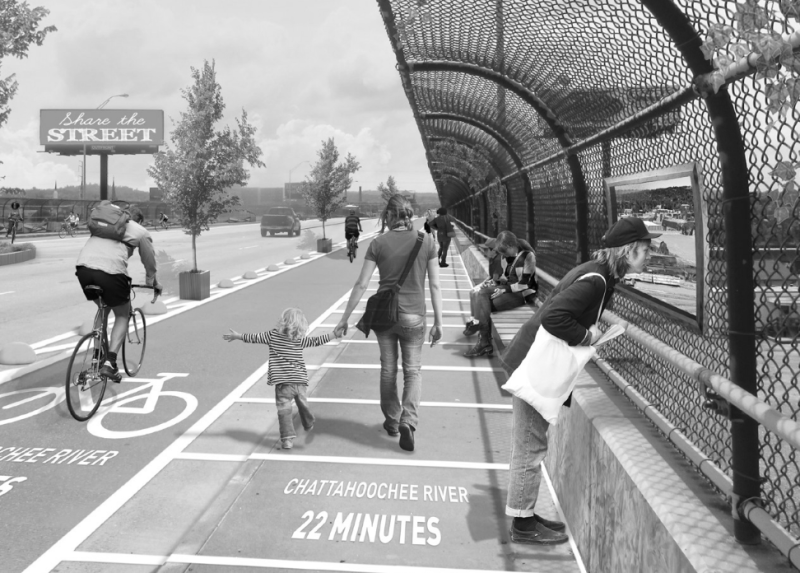


By converting outside traffic lanes of this arterial to parking lanes, sidewalks would become more hospitable and the commercial streetscape could gradually re-emerge from a state of 65% vacancy. They invited us into the conversation and hired Hall Planning & Engineering Inc. (HPE) to provide an economic and engineering report on the impact of a road diet. Together, we developed a tactical project to test the proposed lane changes using traffic cones. HPE collected the data from that pilot demonstrating the viability of a road diet and created a proposal for the City’s approval.
We commend city staff, especially Deputy City Manager Pam Hodge for their clear-sightedness and courage to champion such a big change publicly. Despite highly favorable evidence from the pilot and traffic study, there remained antagonists of the project who opposed change and fear-mongered.
However, the plan was approved and the proof is in the results. With the announcement of 13th Street’s coming transformation, a lease was signed almost immediately on a vacant building. One property owner who attended our training (a gentleman who has a large portfolio and roots three generations deep in the area) started fixing up his buildings. This was a strong signal to other property owners and has kicked off a small flywheel of reinvestment.
The story of 13th Street was a confluence of great timing, existing groundwork from our partners, and the energy and goodwill generated by our training. We did not anticipate this outcome but are delighted that such an important and enduring piece of infrastructure will now be helping locally-driven economic development, not hindering it.
Proactive Planning in Tigard
We are working with the City of Tigard, a first-ring suburb on the edge of Portland, OR to help them be proactive with their zoning amendments using a Stress Test. Tigard understands the importance of walkable neighborhoods, good urban design, and small scale development. As such, they have already brought in several top-notch planning teams to help them create a vision for their city that prioritizes sustainability and happy residents. Their challenge is now to make all of their planning cohesive and to ensure that the zoning ordinances support their plans.
The Stress Test target area in Tigard contains a collection of auto-oriented land uses, including regional shopping centers, medium to large office buildings, and a smattering of single family houses in between. Tigard is exploring how the existing land use pattern can evolve lot by lot with infill and adaptation to create a cohesive, pleasant, and walkable neighborhood. This target area is also preparing for the possibility of a light-rail connection to Portland within the next 20 years, and the impact those stations would make. Tigard has the foresight and desire to protect their local businesses and residents from the speculative inflationary effect that often accompanies rail investment. As such, the City is eager to make sure that small scale, local developers can participate in the build out of the rail corridor before, during and after such a project may occur.
This Stress Test involved identifying lots in the target area and working through hypothetical developments (ex. would a mixed-use fourplex or three-story walkup meet code and be financially viable in the current regulatory and market conditions). The IncDev team led staff and local property owners to recalibrate their code by playing the role of developers on paper. Secondarily, Tigard wisely worked with the IncDev team on their long-term vision, considering the impact of their planning should the rail project never materialize.

Memphis
Our 2016-2017 work in Memphis applied IncDev principles to a large area called the Memphis Medical District to prime the area for workforce housing. We were recruited because a number of medical institutions were unsure how to make the most of their land holdings. They had purchased lots dispersed throughout the area surrounding the hospitals, but none of the lots were especially large and the local market did not support new development. These institutions realized that in order to create quality workforce housing and nearby amenities for their staff, they'd need to jump in together to change the prospects of the market and learn how to work on small lots.
Cultivating Talent
We held a series of training sessions in Memphis to recruit and train local people to perform this development. The Medical District neighborhoods were distressed but not empty so the goal was to generate local prosperity by improving the opportunity and skills of area residents. We held recruitment lectures, two workshops, a boot camp and provided basic technical assistance for about 10 small developer projects at various stages. This has helped cultivate new talent in the development ecosystem and has inspired more confidence in locals who have hesitated to invest.
Implementation Clinic
To investigate how city-level planning issues are affecting work on the ground in the Medical District, we held an Implementation Clinic in March 2017. This helped build relationships and understanding across public and private development groups.
Master Developer
There is more capacity building work to be done so the Medical District is currently engaging a master developer whose role will be to set the stage for the small lot development of our alumni. In particular, this master developer will oversee infrastructure improvements that small developers can’t take on themselves.
Building up the Bus Route in Albuquerque
Albuquerque invested heavily in a Bus Rapid Transit (BRT) line in their city core which will be opening soon. As responsible stewards of city services, they wanted to make sure this BRT line would be financially viable in the long term, which demands property taxes commensurate with the cost of running the service. However, the only available properties along the new line are small lots that will need a particular kind of developer. The City is encouraging small-scale development proactively to "jump start a pipeline of small development projects in Albuquerque."
Following our approach in Memphis, we hosted recruitment lectures, two workshops, a boot camp, and an Implementation Clinic. Albuquerque has implemented a new development ordinance that has made life much easier for small developers, so part of our work has been to help people take advantage of that code change as the City intended. We had about 10 small developers explore projects in the boot camp.

Atlanta Community Builders
Our work in Atlanta is highly targeted. Working with Invest Atlanta since 2017, we have been partners in the Community Builders program, "in response to growing interest from residents on the Westside to learn how to redevelop vacant, abandoned, and blighted commercial and multi-family properties."
Coaching a cohort
Our work in Atlanta is a Boot Camp on overdrive. We've done extensive one-on-one coaching with a cohort of 15 from the Vine City and English Avenue neighborhoods selected by competitive application. Thanks to Invest Atlanta, qualifying graduates of the program can apply for financial resources to help make their projects a reality. There is a strong focus on providing affordable housing and space for local business.
Of this cohort, about five projects are likely to proceed with the support of our team and Invest Atlanta, and an additional four will receive continued coaching after the program. Among those moving strongly in the right direction there are multi-family residential projects, a commercial project, and some important renovation and addition work to single family homes.
Since each of these small developers is a resident of Vine City or English Avenue, we are building capacity in the right people to invest in Westside. By coaching them as a cohort, we have fostered a team of neighbors working together to build something valuable.
A chance to remove obstacles
This work has also evolved into an opportunity to help the City understand where there are regulatory barriers to small development, especially in the Westside where it could make a world of difference.
We knew when we engaged Invest Atlanta in this work that zoning would be an impediment to the projects of our cohort. However, it was necessary to go through the process of designing these projects anyway so that the City could understand how and why zoning is an impediment to the development they want. This is not just a learning experience though - our cohort means business. Together we are drafting development proposals that they can take to the City and to the bank.
As we coach our cohort to the finish line with their projects, our team is working with the City to rezone each parcel in question. This is the short term fix. In the long term, we're helping the City identify code that needs to be changed at a municipal or neighborhood scale to avoid these obstacles going forward. Our Atlanta cohort is trailblazing for many small developers to come.



